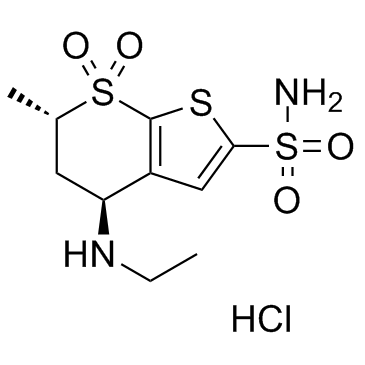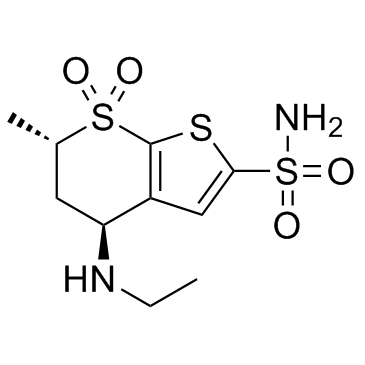Dorzolamide hydrochloride

Dorzolamide hydrochloride structure
|
Common Name | Dorzolamide hydrochloride | ||
|---|---|---|---|---|
| CAS Number | 130693-82-2 | Molecular Weight | 360.90100 | |
| Density | 1.53 g/cm3 | Boiling Point | 575.8ºC at 760 mmHg | |
| Molecular Formula | C10H17ClN2O4S3 | Melting Point | 283-285ºC | |
| MSDS | N/A | Flash Point | 302ºC | |
Use of Dorzolamide hydrochlorideDorzolamide Hcl(L671152 Hcl; MK507 Hcl) is an anti-glaucoma agent, which is a carbonic anhydrase inhibitor.Target: carbonic anhydrase (CA)Dorzolamide hydrochloride is a carbonic anhydrase inhibitor. It is an anti-glaucoma agent, and acts by decreasing the production of aqueous humour [1]. Glaucoma was induced in the right eye of adult Wistar rats by episcleral venous occlusion. One experimental group was administered dorzolamide hydrochloride 2%-timolol 0.5% combination eye drops, while the other experimental group was administered dorzolamide hydrochloride2% eye drops. Control groups had surgery without drug administration. Drug application was initiated either 2 weeks before surgery (Group A), from the day of surgery (Group B), 2 weeks after surgery (Group C), or 4 weeks after surgery (Group D). RGCs were labeled by intratectal Fluorogold injections and counted from flat-mount preparations, and IOP was measured using Tonopen. Both dorzolamide-timolol combination and dorzolamide hydrochloride, when applied topically, significantly reduced IOP and improved RGC densities in experimental eyes when compared to control eyes. Earlier initiation, as well as longer duration of drug application, resulted in higher RGC densities [2].Clinical indications: Glaucoma; Ocular hypertensionFDA Approved Date: 1995Toxicity: Dizziness, headache, shortness of breath, slow heartbeat, severe asthma, cardiac arrest |
| Name | dorzolamide hydrochloride |
|---|---|
| Synonym | More Synonyms |
| Description | Dorzolamide Hcl(L671152 Hcl; MK507 Hcl) is an anti-glaucoma agent, which is a carbonic anhydrase inhibitor.Target: carbonic anhydrase (CA)Dorzolamide hydrochloride is a carbonic anhydrase inhibitor. It is an anti-glaucoma agent, and acts by decreasing the production of aqueous humour [1]. Glaucoma was induced in the right eye of adult Wistar rats by episcleral venous occlusion. One experimental group was administered dorzolamide hydrochloride 2%-timolol 0.5% combination eye drops, while the other experimental group was administered dorzolamide hydrochloride2% eye drops. Control groups had surgery without drug administration. Drug application was initiated either 2 weeks before surgery (Group A), from the day of surgery (Group B), 2 weeks after surgery (Group C), or 4 weeks after surgery (Group D). RGCs were labeled by intratectal Fluorogold injections and counted from flat-mount preparations, and IOP was measured using Tonopen. Both dorzolamide-timolol combination and dorzolamide hydrochloride, when applied topically, significantly reduced IOP and improved RGC densities in experimental eyes when compared to control eyes. Earlier initiation, as well as longer duration of drug application, resulted in higher RGC densities [2].Clinical indications: Glaucoma; Ocular hypertensionFDA Approved Date: 1995Toxicity: Dizziness, headache, shortness of breath, slow heartbeat, severe asthma, cardiac arrest |
|---|---|
| Related Catalog | |
| References |
| Density | 1.53 g/cm3 |
|---|---|
| Boiling Point | 575.8ºC at 760 mmHg |
| Melting Point | 283-285ºC |
| Molecular Formula | C10H17ClN2O4S3 |
| Molecular Weight | 360.90100 |
| Flash Point | 302ºC |
| Exact Mass | 360.00400 |
| PSA | 151.33000 |
| LogP | 4.66680 |
| Vapour Pressure | 2.93E-13mmHg at 25°C |
| Storage condition | Refrigerator |
CHEMICAL IDENTIFICATION
HEALTH HAZARD DATAACUTE TOXICITY DATA
|
| Hazard Codes | Xi |
|---|---|
| RIDADR | NONH for all modes of transport |
| HS Code | 2935009090 |
|
~97% 
Dorzolamide hyd... CAS#:130693-82-2 |
| Literature: RAGACTIVES, S.L. Patent: US2003/220509 A1, 2003 ; Location in patent: Page/Page column 12 ; |
|
~99% 
Dorzolamide hyd... CAS#:130693-82-2 |
| Literature: CIPLA LIMITED; CURTIS, Philip, Anthony Patent: WO2008/135770 A2, 2008 ; Location in patent: Page/Page column 21-22 ; |
|
~% 
Dorzolamide hyd... CAS#:130693-82-2 |
| Literature: WO2011/101704 A1, ; |
| Precursor 2 | |
|---|---|
| DownStream 0 | |
| HS Code | 2935009090 |
|---|---|
| Summary | 2935009090 other sulphonamides VAT:17.0% Tax rebate rate:9.0% Supervision conditions:none MFN tariff:6.5% General tariff:35.0% |
|
Design and in vitro characterization of small unilamellar niosomes as ophthalmic carrier of dorzolamide hydrochloride.
Pharm. Dev. Technol. 19(6) , 748-54, (2014) The objective of this work was to formulate and characterize non-ionic surfactant vesicles (niosomes) as an ocular carrier of dorzolamide hydrochloride (Dorzo); one of the antiglaucoma drugs. Niosomes... |
|
|
Regulation of retinal proteome by topical antiglaucomatous eye drops in an inherited glaucoma rat model.
PLoS ONE 7 , e33593, (2012) Examination of the response of the retinal proteome to elevated intraocular pressure (IOP) and to the pharmacological normalization of IOP is crucial, in order to develop drugs with neuroptorective po... |
|
|
Meta-analysis of α2-adrenergic agonists versus carbonic anhydrase inhibitors as adjunctive therapy.
Curr. Med. Res. Opin. 28(4) , 543-50, (2012) To evaluate the efficacy of α2-adrenergic agonist (AA) brimonidine and topical carbonic anhydrase inhibitors (CAIs) dorzolamide and brinzolamide in reducing intraocular pressure (IOP) when used as adj... |
| (4S,6S)-4-(ethylamino)-6-methyl-5,6-dihydro-4H-thieno[2,3-b]thiopyran-2-sulfonamide 7,7-dioxide hydrochloride |
| 4H-Thieno[2,3-b]thiopyran-2-sulfonamide, 4-(ethylamino)-5,6-dihydro-6-methyl-, 7,7-dioxide, (4S,6S)-, hydrochloride (1:1) |
| Dorzolamide hydrochloride |
| (4S,6S)-4-(Ethylamino)-6-methyl-5,6-dihydro-4H-thieno[2,3-b]thiopyran-2-sulfonamide 7,7-dioxide hydrochloride (1:1) |
| Dorzolamide HCl |
| Dorzolamide |
| (4S,6S)-4-(Ethylamino)-5,6-dihydro-6-methyl-4H-thieno(2,3-b)thiopyran-2-sulfonamide 7,7-dioxide, monohydrochloride |
| (4S,6S)-4-(Ethylamino)-6-methyl-5,6-dihydro-4H-thieno[2,3-b]thiopyran-2-sulfonamid-7,7-dioxidhydrochlorid |
| 4H-thieno[2,3-b]thiopyran-2-sulfonamide, 4-(ethylamino)-5,6-dihydro-6-methyl-, 7,7-dioxide, (4S,6S)-, monohydrochloride |
| (4S,6S)-4-(éthylamino)-6-méthyl-5,6-dihydro-4H-thiéno[2,3-b]thiopyran-2-sulfonamide-7,7-dioxyde chlorhydrate |
| MFCD00884659 |

![(4S,6S)-4-(ethylamino)-5,6-dihydro-6-methyl-4H-thieno-[2,3-b]thiopyran-2-sulfonamide-7,7-dioxide di-p-toluyl-L-tartate salt structure](https://image.chemsrc.com/caspic/451/1227941-29-8.png)
![6-methyl-4-oxo-5,6-dihydro-4H-thieno[2.3-b]thiopyran-2-sulfonamide-7,7-dioxide structure](https://image.chemsrc.com/caspic/306/935289-26-2.png)

